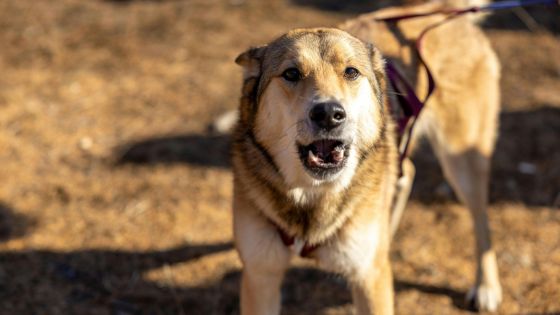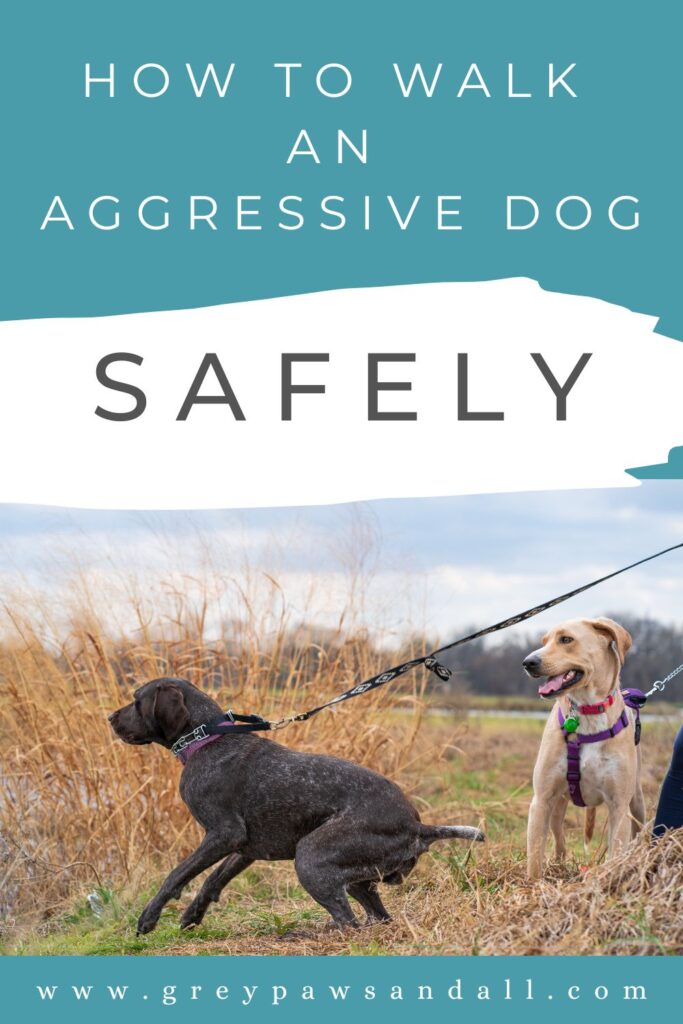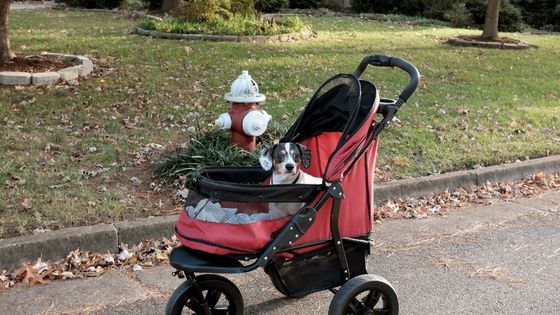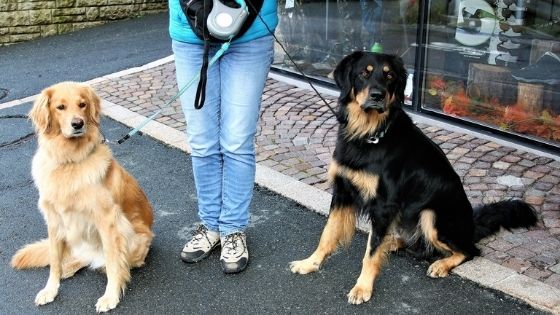If your dog goes after people and other dogs while out on a walk, you need to read this article.
The best way to help a dog that goes after people and other dogs on a walk is through desensitization and counter-conditioning. Desensitization involves gradual exposure to whatever brings on leash aggression, and counter-conditioning means pairing that trigger with a favorite reward, to calm him down.
*There are affiliate links in this post, which means if you make a purchase I may receive a small commission. This has no effect on the price you pay, but does allow me to continue bringing you helpful content.*
Note: The tips below are perfect for helping dogs of all ages.
What is Dog Leash Aggression?
Known as dog leash aggression, it is a dog who becomes aggressive when out on walks wearing a leash, because he feels restrained and uncomfortable in a situation. Often, once a dog is off leash and can remove himself from the approaching “threat,” he’s calmer. This behavior could also be due to health issues such as vision loss which makes walking scary, and that fear can be manifested as aggression.
Questions to Ponder
- Have you recently adopted an older dog and this is how he behaves on every walk?
- Has your dog always been great on a leash, but as he’s getting older he’s becoming aggressive?
Causes of Dog Leash Aggression
- Abuse in your dog’s past
- Lack of training and socialization
- Attacked by another dog or a bad experience caused fear or dislike
- Pain or discomfort
- Vision/hearing impairment causing feelings of anxiety or insecurity
- Loves to play so much he gets frustrated being held back, and it seems like aggression
- Walker giving unintentional signals that cause aggression (I will elaborate on this point below)
Have You Identified the Cause?
Do any of the above points explain your dog’s leash aggression?
• If you think your dog is in pain, a trip to the vet is the first order of business. Managing that pain could possibly end the leash aggression. Read this ⇒ 5 Effective Ways to Reduce Pain in Dogs with Arthritis
• If your older dog is dealing with vision/hearing loss, mobility issues and other medical conditions, I’m going to assume he or she is being treated for all issues. If that’s the case, walking early in the morning and later in the evening in a quiet area where few people or dogs are, can help. In many cases, avoiding the triggers is the best solution.
Read this ⇒ A Guide to Caring for Your Blind Dog
Read this ⇒ How to Tell if Your Dog is Deaf
Lack of training, unintentional signals and bad experiences can be helped using desensitization and counter-conditioning.
Walker giving unintentional signals: I wanted to elaborate on this point. The first time a walker experiences leash aggression, instinct is to tighten up on the leash to hold the dog back. It’s been mine as well! The problem with this is –
The walker is on edge each time they’re out, and that tension can be sensed by the dog through the leash! He is now learning he has good reason to be scared/fearful.
When a dog is going through “attack training,” tightening up on the leash is exactly what you’re taught to do, hence the dog is being “unintentionally” trained to attack. Don’t worry, training can help!
Let’s Look at a Leash Aggression Scenario
When dogs are off leash, whether they approach each other in an arc or head on, they sniff then have the option to hang out or move on.
That’s in contrast to a dog who is on leash, is approached by a dog and there’s nowhere for him to go. Fear and anxiety can build up. These feelings are intensified when the walker stops to chat, keeping the dog in this state longer and longer. As the dog strains against the leash, the walker is tightening it, holding the dog back, confirming for the dog there is a reason to feel threatened.
Dogs sense the change in our behavior and body language, feeling the tension all the way through the leash. Now not only are you on edge, but so is the dog, creating a vicious cycle that will never end.
Let’s say you’re not stopping to chat, just walking minding your own business, and your dog starts barking and lunging at a “threat.” Since you and the “threat” are carrying on walking, eventually it will disappear. What’s interesting here is your dog has just learned if he’s aggressive enough, the threat goes away. Now you have a vicious circle!

Consequences of Leash Aggression
• Difficult, stressful, scary and a nightmare for everyone.
• The more unpleasant walking your dog is, the less often it’s going to happen.
• The less often it happens, the more pent-up energy you dog has to release.
• The more pent-up energy he has to release, the worse his behavior gets.
• The worse his behavior gets, the more impossible he is to walk until he doesn’t get walked at all.
The final result – not good.
NOTE: Please never punish your dog for his behavior, it’s not his fault. Instead, start following the recommendations outlined below.
Before Your Leash Aggression Training Starts
Teach the “look at me” cue
During the training you’ll want your dog to focus on you, so if your dog doesn’t know the “look at me” cue, now’s the time to teach it.
Lean over and start quite close to your dog’s face, but be sure you have a good enough relationship to know he’ll be comfortable with that. You need to be close because it keeps you engaged.
Hold the treat in your hand at your forehead, when your dog looks at you say “look at me” then say “yes” in an excited voice and give the treat.
Practice that several times until he gets it, now it’s time to phase out the treat and phase in the hand signal.
Put the treat in one hand and keep it in your lap or by your side. Put the index finger of your other hand to your forehead, say “look at me” and when he looks say “yes” and treat. We do this because ultimately you want your dog to focus on you, not the food
When your dog has mastered “look at me” in a quiet environment, start training in more and more distracting locations. If your dog fails to look at you, you’ve moved too far too fast. Take a step back and practice some more.
Tire him out
Tire him out a little before your walk, by playing with him for a few minutes. A tired dog may be less reactive.
Loose leash
Walk with a loose leash, but please keep a firm grip in case you have to pull him back quickly.
Relax
Your state affects his state, so be casual, be cool, put your headphones on and listen to calming music.
Pay attention to body language
What changes occur when he starts to get aggressive?
- Does he stop?
- Turn around?
- Do you hear the beginnings of a growl?
- Strains against the leash?
It can seem like there’s no warming before he lunges but there are signs, they just may be very subtle and quick. If you can intervene at the first hint, you’ll have a better chance of preventing full out aggression.
When you first start, don’t beat yourself up if you aren’t noticing the signs and he goes full out aggression. Trust me, I’ve been there many times! At this point, any attempts to get him to listen will fail, so remove him from the situation as quickly as possible.

Avoidance Techniques
These are things you can do, as soon as you see something you know your dog will react to. Don’t wait until you get closer, act as soon as possible. The more often you’re able to avoid a triggering situation, the calmer your dog will be, and the more exercise he’ll get.
Read this ⇒ 18 Ways to Exercise a Dog Indoors
• Cross the road, or change direction.
• If a dog is approaching head on, if there’s room make a large arc around him, keeping calm and not saying a word. If he didn’t react reward him with some treats.
• Stick to quiet areas and change walk times, so encountering others is less likely.
• If you have a small dog that can easily be picked up do it, then change direction. Don’t do this all the time as a way of training, and definitely not if your dog is already reacting. You can get hurt!
Avoidance techniques are just band aids, and won’t help your dog get over his leash aggression. You’re also denying a social creature the opportunity to interact with people and others of his kind, which really isn’t fair.
Having said that, if you’re feeling lazy (which we all do at times), or aren’t yet confident that you can change things (which you can!!), minimizing the amount of contact may be a good way to start the training, since you won’t be bombarded by “threats” all at once.
Fix Leash Aggression Using Desensitisation and Counter-Conditioning
I touched briefly on these two terms in the beginning of this article, but I’ll mention it again. In this case, desensitization involves gradual exposure to whatever brings on leash aggression, and counter-conditioning means pairing that trigger with a favorite reward (usually a delicious treat), to calm him down.
For the training you’ll need a treat pouch with a wide opening for easy access, and some food he absolutely loves but doesn’t get very often. It’s best to save the really good stuff for this training.
This is super important: There is a distance or range within which a leash aggressive dog will be fine, but any closer he will start to react. By “react” I mean even the smallest sign, NOT waiting until he’s full on lunging.
Do you know what that distance is for your dog? If not, start taking notice when on your walk. You don’t need to know the exact measure, just roughly.
NOTE: It’s not necessary to pick one training method and stick with it. Try one in the morning, and another in the afternoon for example.
Training Method One
• Recruit someone you know with a very calm dog.
• Start off with them a bit farther than that safe range we talked about, and that means distance in front of you and to the side.
• Slowly walk towards each other.
• While still in that safe zone stop, ask your dog to sit, say “look at me” then give him treats one after the other, praising him the whole time until your friend and dog have passed.
• Now carry on with your walk, don’t say anything or even look at him. You want to be casual so he knows nothing happened, no big deal.
• Repeat this exercise a couple more times, then try again the next day.
NOTE: Your goal, over time, is to pass each other at a closer and closer distance. You may stay at the same distance for days or weeks, and that’s perfectly okay. There’s no rush, it takes as long as it takes. Moving too quickly before your dog is ready, could impact the progress you’ve made.
Depending on the level of your dog’s anxiety and leash aggression, you may never get to the point where you’re going on walks together with dogs side by side…and that’s okay. Whatever progress you make is amazing.
Training Method Two
If you don’t have a friend to practice with, go to an area where you know people walk their dogs, but pick a time it’s likely to be quieter so he’s not bombarded all at once. While walking, keep distance between yourself and other dogs, but allow them to be within your dog’s sight.
Don’t go to an off-leash area, because you don’t want dogs running up and getting in your dog’s face. Reward your dog while walking, only when he’s calm.

Training Method Three
Whether it’s a boardwalk or a park, find a bench slightly off the beaten track and watch the world go by with your dog. As we’ve discussed, make sure it’s close enough your dog can see other dogs/people… but far enough away he’s relaxed. Once in a while give him a treat, as long as he’s calm.
This is a good way to start, if you’re feeling anxious about a confrontation.
Training Method Four
This is the technique I used to help Jack, my very leash aggressive dog.
Let me start by saying – I was very nervous at the beginning because Jack was extremely difficult, and walks were a nightmare. Sometimes I got the timing wrong, and I ended up with full blown leash aggression. Sometimes I just didn’t have the energy and avoided all triggers.
It’s obvious Jack was never trained or socialized, and I’m sure he was mistreated as well, so I knew his aggression was fear based.
Here is, step by step, what I did.
• I bought a pouch with a wide opening so I could easily grab treats
• I filled it with food Jack loves, and only used it for this training
• I was on high alert, constantly looking for any perceived “threats” in the distance so I could be ready, while trying to relax at the same time!
• I always kept a few treats in my hand – the key is to treat immediately
• My dogs always walk on my left, so choose whichever side works best for you
• I reacted the second I saw a person/dog coming our way, no matter how far away they were
As soon as I saw a dog/person coming, I positioned myself in front of Jack to block his view. Without saying a word, I gave him treats, one after the other, after the other (and I mean that literally) until the “threat” passed. We then continued on our walk.
That is all there is to it.
For this method to work you need to act immediately, and be consistent. That means, every single time you’re out you have to notice your surroundings, and follow the steps above.
There will be times when you’ll panic and forget what to do when. There will be times where your dog will have already spotted the problem, and the only thing you can do is manage the situation until the other person/dog passes. Forget trying to give treats, it won’t work, and you don’t want to mistakenly reward the behavior. We’re all human, so don’t worry about it. It will be better next time.
How Long Before You Start to See a Change in Leash Aggression?
It’s impossible to say, since all dogs are different and so is their anxiety level. I worked with Jack for many months, and long after I saw a massive improvement, I still carried my treat pouch just in case!
It’s been years since I’ve needed treats, and he’s so much more relaxed passing close to dogs and people. Is he tolerant of every dog approaching? No, but he doesn’t react like he used to. Can a random person come over and pet him? Absolutely not, and I’m okay with that! Are walks pleasant? Absolutely!

Walking a Senior Dog in Poor Health
The training advice discussed above will help dogs of all ages. Having said that, if you know the challenges are due to your senior dog just not feeling well or dealing with vision loss for example, here are some tips that may be more suitable to your situation.
• Stick to times of the day when there’s less car and foot traffic
• Find quieter areas to walk, although that may mean having to drive there
• Invest in a stroller or wagon and bring it on your walks. It’s possible mobility issues are causing discomfort, so having a way to get him out and enjoying the sights in comfort makes a difference. That’s what I do when I walk Jack.
• Take shorter walks 3 or 4 times a day, rather than one or two longer ones will be easier on the joints, and less opportunity to run into something that may scare your dog.
• If it’s been awhile since your last vet appointment, why not schedule another one. The medication may not be working as well as it should, or he may have a new issue that needs dealing with.
Anxious Dog Accessories
Something worth looking into are accessories that warn people your dog is anxious. You can get leashes, collars, harnesses and vests that say “nervous” – “give me space” – “anxious.” I don’t recommend you rely solely on them to warn people to keep their distance.
I have two leashes – the yellow one says “nervous” the red one “do not pet.” I was shocked at how often people ignored them. Here’s one example: I was sitting on the ferry one day, and a woman next to me asked why my dog was wearing a “nervous” leash. I explained all about how he was mistreated and afraid of people that bent over him, or put out a hand to pet him. I explained he would go after her because he’s scared. What did she do? That’s right, she tried to pet him. You can’t fix stupid!!
Natural Treatments for Senior Dog Anxiety
There are a wide variety of natural treatments to help calm an anxious dog. They are good for training and daily life if you find your dog experiencing generalized anxiety.
Read this ⇒ How to Calm Dog Anxiety Natural (22 Easy Ways)
I do hope you’ve found this post helpful, and you will start seeing results soon. Reasons for leash aggression differ, and while this training does help, please be realistic in your expectations. Any progress you make in reducing your dog’s anxiety level when walking is a win for everyone.
Do you know why your dog is leash aggressive? What things have you tried that make walking easier? Sharing helps others, so please leave them in the comment section below.
I am a Senior Dog Care Consultant, helping senior dog parents struggling with anticipatory grief, quality of life and health & wellness issues. I offer practical tips, advice and one on one support. Click this link to book a FREE 20 minute discovery call, visit my services page to find out more or email hindy@greypawsandall.com if you have any questions.
I’ve been rescuing and caring for senior dogs since 2009. From vision and hearing loss to obesity, dementia, kidney disease, liver issues, cardiac problems, Cushing’s, mobility challenges and more, you could say I’ve dealt with and learned a lot! In addition to my hands on experience, I’ve taken many courses and earned several qualifications to keep learning how to help senior dogs and they include: Senior Dog Enrichment, Understanding Canine Anxiety, Care of the Senior Pet and I’m a Certified Pet Loss Specialist.

